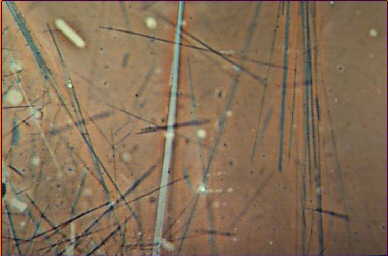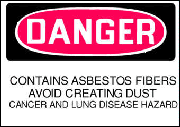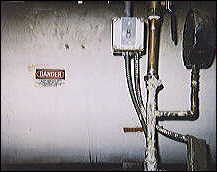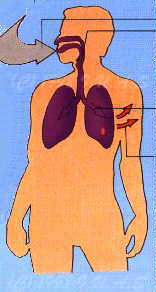![]()
Unlike other hazards which you may avoid through luck, if you fail to take precautions against asbestos, it will eventually kill you! Even if you kid yourself by ignoring the other safety advice, you are beyond any reasonable doubt committing suicide if you fail to adequately protect yourself against asbestos. |
 © ACF 2000 |
Asbestos is the major problem for any urban explorer who explores abandoned buildings. Many buildings will be abandoned because of asbestos. Investing in a respirator (as pictured above right) and protective clothing is a must. A dust mask won't cut it although it is better than nothing. Make sure you know what asbestos looks like, and where it can be found as well as how to minimise exposure.
Asbestos fibres will cling to your shoes and clothing. That it is why it is important not to trail these fibres home. Wash your shoes after leaving an area contaminated with asbestos. You should wear protective clothing and upon leaving the contaminated site this should be washed off and stored in a sealed plastic bag. You should not wait until you arrive at home to do this as you will just spread the fibres around there. Shaking out the protective clothing will not clean them, it will just spread the fibres into the air and into your lungs
If you plan to explore abandoned buildings as a hobby you must invest in a proper respirator and protective clothing. The cost may just save your life, and it is a good camouflage anyway. Anybody seeing you wandering through an abandoned building wearing these will probably think you are supposed to be there. If they do question you, then you can act concerned or agitated and tell them to get the hell out of the areas before they kill themselves from asbestos contamination.
Asbestos is the name applied to six naturally occurring minerals that are mined from the earth. The different types of asbestos are:
Of these six, three are used more commonly. Chrysotile (white) is the most common and currently accounts for more than 98% of world asbestos consumption , but it is not unusual to encounter Amosite (brown / off-white), or Crocidolite (blue) as well. White asbestos has been considered to be less harmful than blue or brown asbestos as the fibres are larger and less likely to break. This is a falsehood - white asbestos will kill you just as dead as blue or brown asbestos, it will just take longer.
All types of asbestos tend to break into very tiny fibres. These individual fibres are so small that many must be identified using a microscope. In fact, some individual fibres may be up to 700 times smaller than a human hair. Because asbestos fibres are so small, once released into the air, they may stay suspended there for hours or even days.
Asbestos fibres are also virtually indestructible. They are resistant to chemicals and heat, and they are very stable in the environment. They do not evaporate into air or dissolve in water, and they are not broken down over time. Asbestos is probably the best insulator known to man. Because asbestos has so many useful properties, it has been used in over 3,000 different products.
Usually asbestos is mixed with other materials to actually form the products. Floor tiles, for example, may contain only a small percentage of asbestos. Depending on what the product is, the amount of asbestos in asbestos containing materials (ACM) may vary from 1%-100%.

© ACF 2000
Magnified asbestos fibres
Asbestos may be found in many different products and many different places. Examples of products that might contain asbestos are:

Warning signs should be posted, but don't count on it!
The most common way for asbestos fibres to enter the body is through breathing. In fact, asbestos containing material is not generally considered to be harmful unless it is releasing dust or fibres into the air where they can be inhaled or ingested. Many of the fibres will become trapped in the mucous membranes of the nose and throat where they can then be removed, but some may pass deep into the lungs, or, if swallowed, into the digestive tract. Once they are trapped in the body, the fibres can cause health problems.
Asbestos is most hazardous when it is friable. The term "friable" means that the asbestos is easily crumbled by hand, releasing fibres into the air. Sprayed on asbestos insulation is highly friable. Asbestos floor tile is not.
Asbestos-containing ceiling tiles, floor tiles, undamaged laboratory cabinet tops, shingles, fire doors, siding shingles, etc should not release asbestos fibres unless they are disturbed or damaged in some way. If an asbestos ceiling tile is drilled or broken, for example, it may release fibres into the air. My experience as a health inspector has shown that general wear and tear of ceiling tiles has in fact been sufficient to increase asbestos levels in some buildings by over 235 percent. This is particularly so in buildings subject to vibration from traffic.

Asbestos lagging on pipes and in walls
Asbestos pipe and boiler insulation does not present a hazard unless the protective covering is cut or damaged in such a way that the asbestos underneath is actually exposed to the air. However, this said, most pipe lagging that I have seen is poorly maintained and often in a damaged state.
Damage and deterioration will increase the friability of asbestos-containing materials. Water damage, continual vibration, aging, and physical impact such as drilling, grinding, buffing, cutting, sawing, or striking can break the materials down making fibre release more likely.
Because it is so hard to destroy asbestos fibres, the body cannot break them down or remove them once they are lodged in lung or body tissues. They remain in place where they can cause disease. The first rule to remember regarding toxic dust and fibres is that it is the microscopic fibres, not seen by the naked eye, that can cause the damage. Fibres smaller than 10 microns are the ones that remain airborne, and can penetrate the human defence mechanism for trapping dust, which are the nose, trachea, passing to the lungs and other parts of the body.
 |
Images © ACF 2000
|
 |
Asbestos fibres can enter the body through inhalation or ingestion. Inhaled fibres are mostly trapped in the nose, the smaller particles which penetrate the nose are trapped in the trachea mucous and conveyed back to the mouth by the airway clearance mechanism. This mechanism is composed of small hair like cells called cilia. The cilia maintain a constant upward motion to remove the mucous from the trachea into the mouth, where the mucous is swallowed and in turn is conveyed to the gastrointestinal tract. The lungs and stomach are surrounded by a protective lining called the pleura The space between the pleura and the walls of the lung is called the peritoneal cavity. Asbestos fibres may be deposited in the pleura, via the lymphatic drainage system. The rest of the fibres are deposited into the lungs.
Most of the ingested asbestos is excreted in feces. A small portion, however, penetrates the walls of the gastrointestinal tract, where fibres may be deposited.
There are three primary diseases associated with asbestos exposure:
Asbestosis is a serious, chronic, non-cancerous respiratory disease. Inhaled asbestos fibres aggravate lung tissues, which causes them to scar. Symptoms of asbestosis include shortness of breath and a dry crackling sound in the lungs while inhaling. In its advanced stages, the disease may cause cardiac failure.
There is no effective treatment for asbestosis; the disease is usually disabling or fatal. The risk of asbestosis is minimal for those who do not work with asbestos; the disease is rarely caused by neighborhood or family exposure. Those who renovate or demolish buildings that contain asbestos may be at significant risk, depending on the nature of the exposure and precautions taken.
Lung cancer causes the largest number of deaths related to asbestos exposure. Approximately 20% of all asbestos related deaths are due to lung cancer. The incidence of lung cancer in people who are directly involved in the mining, milling, manufacturing and use of asbestos and its products is much higher than in the general population. The most common symptoms of lung cancer are coughing and a change in breathing. Other symptoms include shortness of breath, persistent chest pains, hoarseness, and anemia.
People who have been exposed to asbestos and are also exposed to some other carcinogen -- such as cigarette smoke -- have a significantly greater risk of developing lung cancer than people who have only been exposed to asbestos. One study found that asbestos workers who smoke are about 90 times more likely to develop lung cancer than people who neither smoke nor have been exposed to asbestos.
Latency period (Ie, delayed effect) may range from 15 years for those with heavier exposures to 25 years for less intense exposure, from onset of exposure. Fifteen years is probably the minimum latency period. The peak increase in cancer rate occurred about 30-35 years after the onset of exposure A characteristic of many cancers is a marked increase in incidence with advancing age. This is probably due to the less efficient immune surveillance system in older individuals. Studies conducted on the additive effect of smoking and asbestos exposure, indicate a definite increase in cancer rate.
Mesothelioma is a rare form of cancer which most often occurs in the thin membrane lining of the lungs, chest, abdomen, and (rarely) heart. As many as 8% - 11% of all asbestos related deaths are of this type. Mesothelioma is probably the most disabling and painful type of asbestos related disease. Death is usually very slow and painful. About 200 cases are diagnosed each year in the United States. Virtually all cases of Mesothelioma are linked with asbestos exposure. Approximately 2 percent of all miners and textile workers who work with asbestos, and 10 percent of all workers who were involved in the manufacture of asbestos-containing gas masks, contract Mesothelioma
People who work in asbestos mines, asbestos mills and factories, and shipyards that use asbestos, as well as people who manufacture and install asbestos insulation, have an increased risk of Mesothelioma So do people who live with asbestos workers, near asbestos mining areas, near asbestos product factories or near shipyards where use of asbestos has produced large quantities of airborne asbestos fibres.
Evidence suggests that cancers in the esophagus, larynx, oral cavity, stomach, colon and kidney may be caused by ingesting asbestos. This means that if you eat or drink food or drink contaminated with asbestos you can expect cancer to commence. For more information on asbestos-related cancers, contact your local chapter of the American Cancer Society.
Three things seem to determine your likelihood of developing one of these asbestos related diseases:
Because each exposure to asbestos increases the body burden of asbestos fibres, it is very important to reduce and minimize your exposure.
The 1990's have seen significant advances in the understanding of mechanisms of fibre-induced disease. Today it is known that the risk of fibre related disease is determined by essentially 3 factors:
In general, long, thin, durable fibres are the most hazardous to health. Fibres
shorter than 5 microns in length are not considered to present a health risk
because of the ability of the body's natural defence mechanisms to deal effectively
with contaminants of this size and nature.
Based on both animal and human studies, all forms of asbestos have been classified as Class I "known human carcinogens" by the International Agency for Research on Cancer. However, there is also a clear international scientific consensus that chrysotile is less hazardous than the amphibole varieties of asbestos. Not only is chrysotile a less dusty material because of its physical properties, it also has a tendency to break down and dissolve in body fluid and thus is more easily cleared from the lungs by natural defence mechanisms.
Amphibole forms, on the other hand, are more dusty materials as well as more durable and persist in the lung once inhaled. The increased potency of amphibole forms of asbestos to chrysotile is corroborated by both animal and human studies.
In order to avoid being exposed to asbestos, you must be aware of the locations it is likely to be found. If you do not know whether something is asbestos or not, assume that it is until it is verified otherwise. Remember that you cannot tell if floor or ceiling tiles contain asbestos just by looking at them.
If you have reason to suspect that something is asbestos, either because it is labeled as such, or because it something that is likely to contain asbestos (9" floor tile, for example) DO NOT DISTURB IT.
Never:
any asbestos-containing materials or suspected materials.
If you need to do work that might involve asbestos (lifting ceiling tiles, repairing insulated pipelines, etc.), check to find out what can be done safely.
For example, before moving any ceiling tiles to perform maintenance work, it will be necessary to ensure they do not contain asbestos. If they do contain asbestos, they will need to be removed by licensed asbestos abatement workers before the work may be performed.
Housekeepers and custodians should never sand or dry buff asbestos containing floor tiles, and only wet stripping methods may be used during stripping operations. Low abrasion pads should be used at speeds below 300 rpm.
Broken and fallen ceiling tiles should be left in place until identified. Only after they have been identified as safe may they be removed. Asbestos tiles will be removed by asbestos abatement workers.
Broken and damaged asbestos floor tiles must also be removed by asbestos abatement workers.
It is important to report any damaged asbestos-containing materials immediately. If, for example, you discover some sprayed-on asbestos insulation has been knocked off of a ceiling or wall, this would be considered a "spill." As such it would need to be cleaned up immediately by asbestos abatement workers. Do not attempt to clean up spills yourself! Disturb the material as little as possible. Also report any damaged pipe insulation, ceiling tile, 9" floor tile, fallen clumps of sprayed-on insulation, etc. Take measures to prevent others from disturbing the spill until the Asbestos Abatement crew arrives.
By knowing where asbestos is likely to be located and then taking measures not to disturb it, you will protect yourself and others from exposure to this hazardous substance.
More detail on where asbestos is found
Fireproofing -- Since the 1950's, one of the most common applications for asbestos was in fireproofing insulation on structural steel in multistory buildings. Sprayed-on fireproofing is required for high-rise buildings in most US cities; before 1973, many city codes actually required that asbestos-containing products be used. In 1973, the EPA banned the use of fireproofing containing more than 1% asbestos. In many cases, these fireproofing materials are concealed by a suspended ceiling, the space used for return air in building ventilation systems. In its 1984 survey of over 200 buildings in 10 US cities, the Environmental Protection Agency found asbestos-containing fireproofing or soft acoustical plasters in 5% of the buildings it examined. In a sample of over 300 buildings that have been surveyed across the United States, there were approximately 12% with asbestos-containing fireproofing.
Acoustical Plasters -- A very common application for asbestos in the late 1960's and early 1970's was a soft acoustical plaster used as a ceiling treatment. This application was extensively used in schools and other public buildings, particularly in reinforced concrete structures. In its study, the EPA did not differentiate between these ceiling treatments and fireproofing materials described in the previous paragraph. In Environmental Concepts experience, these ceiling materials have been found in 8% of the buildings which were surveyed. Although neither the EPA study nor Environmental Concepts have examined large numbers of private residences, such soft acoustical plasters are known to have been used extensively in homes, particularly with the type of architecture prevalent in the Southwest.
Pipe and Boiler Insulation -- By far the most common application for asbestos-containing insulation materials was on steam and domestic hot water piping systems, boilers, chillers, and water heaters. By the EPA's estimate, asbestos-containing pipe or boiler insulation is present in approximately 16% of the US building stock. These materials were present in 48% of the buildings that were surveyed. Of the asbestos-containing pipe and boiler insulation identified, 34% contained amosite asbestos. As discussed previously, amosite asbestos was frequently used in pipe and boiler insulation materials because of its water repellent properties.
Ceiling Tiles -- While not as prevalent as some of the other asbestos-containing products, both drop ceiling and stick-on ceiling tiles have also been found to contain asbestos. Although EPA found asbestos-containing ceiling tiles in only 0.1% of the buildings which it surveyed. Environmental studies however, found asbestos-containing ceiling tiles in 9% of the buildings that were surveyed.
The American Cancer Society - Images on this page © by The American Cancer Foundation
The Asbestos information Center - New York
Occupational
Safety & Health Association
![]()
|
You
are visitor
 to this page since 20/7/01
to this page since 20/7/01 |
Best
Viewed at
|
|
| About this site |
|
©Copyright
notice
© This entire site is copyrighted 1997 - 2006. No image or text may be reproduced, edited, copied, stored in any off-line storage device, or placed on any another website at any time, without written permission from Panic!, web site owner. |